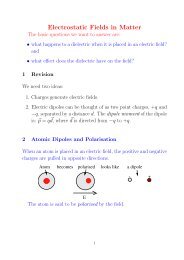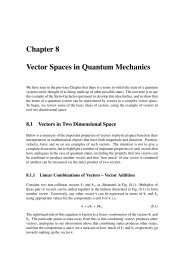Three-vector and scalar field identities and uniqueness theorems in ...
Three-vector and scalar field identities and uniqueness theorems in ...
Three-vector and scalar field identities and uniqueness theorems in ...
You also want an ePaper? Increase the reach of your titles
YUMPU automatically turns print PDFs into web optimized ePapers that Google loves.
a) Electronic mail: dalew@ics.mq.edu.au1 F. Rohrlich, “Causality, the Coulomb <strong>field</strong>, <strong>and</strong> Newton’slaw of gravitation,” Am. J. Phys. 70, 411–414 (2002).2 J. A. Heras, “Comment on ‘Causality, the Coulomb <strong>field</strong>,<strong>and</strong> Newton’s law of gravitation,’ by F. Rohrlich, [Am.J. Phys. 70, 411–414 (2002)],” Am. J. Phys. 71, 729–730(2003).3 F. Rohrlich, “The validity of the Helmholtz theorem,” Am.J. Phys. 72, 412–413 (2004).4 J. A. Heras, “Jefimenko’s formulas with magnetic monopoles<strong>and</strong> the Liénard-Wiechert <strong>field</strong>s of a dual-chargedparticle,” Am. J. Phys. 62, 525–531 (1994).5 J. A. Heras, “Comment on ‘Alternate ‘derivation’ ofMaxwell’s source equations from gauge <strong>in</strong>variance of classicalmechanics,’ by James S. Marsh [Am. J. Phys. 61,177–178 (1993)],” Am. J. Phys. 62, 949–950 (1994).6 D. A. Woodside, “Uniqueness <strong>theorems</strong> for classical four<strong>vector</strong><strong>field</strong>s <strong>in</strong> Euclidean <strong>and</strong> M<strong>in</strong>kowski spaces,” J. Math.Phys. 40, 4911–4943 (1999).7 D. A. Woodside, “Classical four-<strong>vector</strong> <strong>field</strong>s <strong>in</strong> the relativisticlongitud<strong>in</strong>al gauge,” J. Math. Phys. 41, 4622–4653(2000).8 A. Sommerfeld, Mechanics of Deformable Bodies (Academic,New York, 1964), Vol. II, pp. 147–151.9 R. E. Coll<strong>in</strong>, Field Theory of Guided Waves (McGraw-Hill,New York, 1960), pp. 564–568.10 R. Plonsey <strong>and</strong> R. E. Coll<strong>in</strong>, Pr<strong>in</strong>ciples <strong>and</strong> Applicationsof Electromagnetic Fields (McGraw-Hill, New York, 1961),pp. 29–36.11 G. Arfken, Mathematical Methods for Physicists, 3rd ed.(Academic, Orl<strong>and</strong>o, 1985), pp. 78–84.12 R. W. P. K<strong>in</strong>g, Fundamental Electromagnetic Theory, 2nded. (Dover, New York, 1963), p. 163.13 A. M. Stewart, “Vector potential of the Coulomb gauge,”Eur. J. Phys. 24, 519–524 (2003).14 V. Hnizdo, “Comment on ‘Vector potential of the Coulombgauge’,” Eur. J. Phys. 25, L21–L22 (2004).15 V. P. Dmitriyev, “On <strong>vector</strong> potential of the Coulombgauge,” Eur. J. Phys. 25, L23–L27 (2004).16 A. M. Stewart, “Reply to Comments on ‘Vector potentialof the Coulomb gauge’,” Eur. J. Phys. 25, L29–L30 (2004).17 A. M. Stewart, “On an identity for the volume <strong>in</strong>tegral ofthe square of a <strong>vector</strong> <strong>field</strong>,” Am. J. Phys. 75, 561–564(2007).18 J. T. Cush<strong>in</strong>g, Applied Analytical Mathematics for PhysicalScientists (Wiley, New York, 1975), pp. 511–516.19 J. D. Jackson, Classical Electrodynamics, 2nd ed. (Wiley,New York, 1975), pp. 608–612.20 N. Cabibbo <strong>and</strong> E. Ferrari, “Quantum electrodynamicswith Dirac monopoles,” Nuovo Cimento 23, 1147–1154(1962).21 O. D. Jefimenko, Electricity <strong>and</strong> Magnetism, 2nd ed. (ElectrectScientific, Star City, 1989), p. 516.22 E. Kapuścik, “Generalized Helmholtz theorem <strong>and</strong> gauge<strong>in</strong>variance of classical <strong>field</strong> theories,” Lett. Nuovo CimentoSoc. Ital. Fis. 42, 263–266 (1985).23 R. Adler, M. Baz<strong>in</strong>, <strong>and</strong> M. Schiffer, Introduction to GeneralRelativity, 2nd ed. (McGraw-Hill, New York, 1975),pp. 88, 115–116.10
















